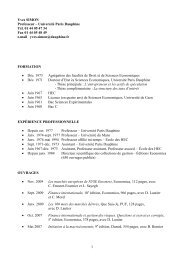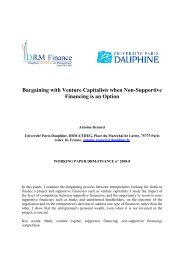Corporate governance and earnings management ... - CEREG
Corporate governance and earnings management ... - CEREG
Corporate governance and earnings management ... - CEREG
Create successful ePaper yourself
Turn your PDF publications into a flip-book with our unique Google optimized e-Paper software.
confers a certain value” (CNC, 1982, p. 120). Thus a degree of incentive for amortization for<br />
accounting (rather than tax) purposes appeared. A survey of the treatment of goodwill in<br />
financial statements of the largest French groups between 1988 <strong>and</strong> 1998 shows that almost<br />
one half of these groups applied a systematic amortization of goodwill. This confirms a clear<br />
evolution towards the dynamic approach (Richard, Becom Simons & Secafi Alpha, 2000, p.<br />
168).<br />
The move towards the dynamic approach was confirmed by the regulations governing<br />
consolidated accounts. Decree 67-236 on companies, amended following the law of 1985 on<br />
consolidated financial statements, ruled that unallocated goodwill arising on first<br />
consolidation “must be included in income over a period of amortization”, while regulation<br />
99-02, paragraph 21130 of 1999, stated that “the amortization period must… reflect the<br />
assumptions used <strong>and</strong> objectives evidenced at the time of acquisition”.<br />
It is true that even regulation used the flexibility allowed by the seventh directive <strong>and</strong><br />
introduced for French groups the possibility to write off goodwill against reserves. But,<br />
contrary to its German counterpart, French regulation stated that this write off could only<br />
happen “in exceptional circumstances duly justified in the note” (Decree of 23 March 1967<br />
modified in 1986, § 248-3). Obviously, the French legislator wanted to restrain the use of the<br />
weakened static approach in favor of the dynamic view.<br />
Survey of practices of French groups provides evidence of the (forced) alignment of these<br />
groups on dynamic theses. Richard et al. (2000, p. 163-164) show that from 1987 to 1998, the<br />
systematic amortization of goodwill (over a longer <strong>and</strong> longer period, reaching more that 10<br />
years in 92% of cases in 1998) became the rule for the 100 largest groups, whereas the write<br />
off against reserves concerned at the end of the period only 2 or 3 groups.<br />
The last issue deserving our interest is pooling. At the beginning of the period, the method<br />
is unknown in regulation as it is unknown in practice (Raffegeau, Dufils & Corre, 1986, p.<br />
444) although its use became possible, under certain conditions, with the article 20 of the<br />
51



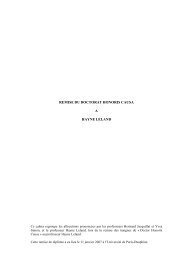

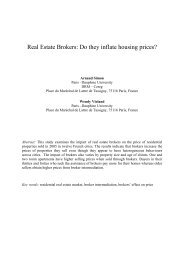
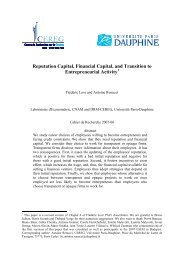

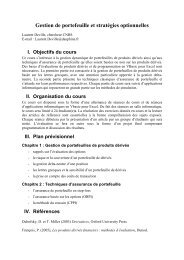



![& 6 ] ^ F ]^ - CEREG - Université Paris-Dauphine](https://img.yumpu.com/33326502/1/184x260/-6-f-cereg-universitac-paris-dauphine.jpg?quality=85)

